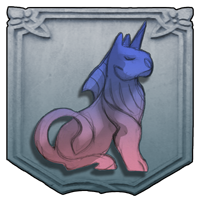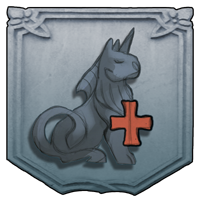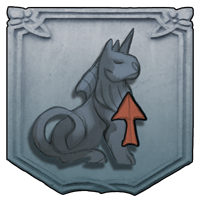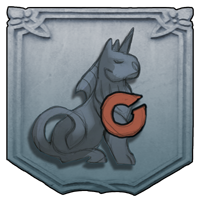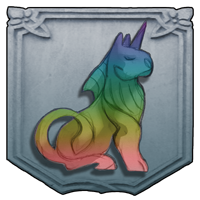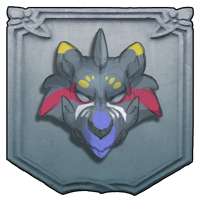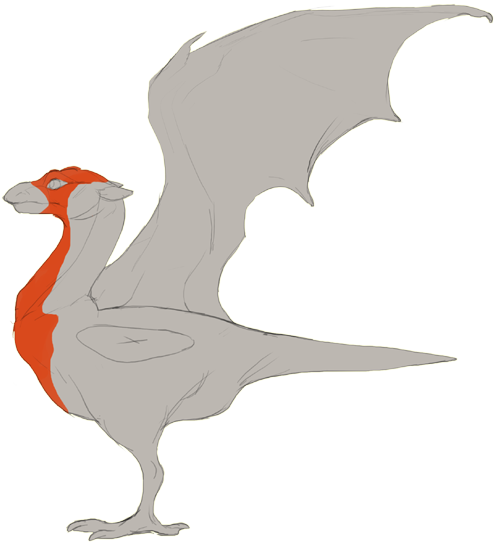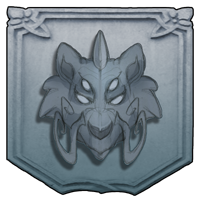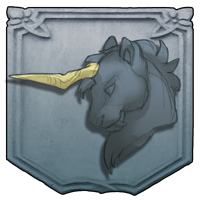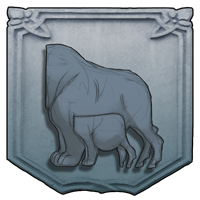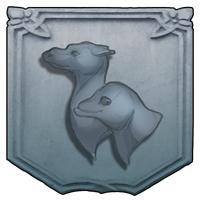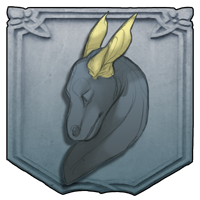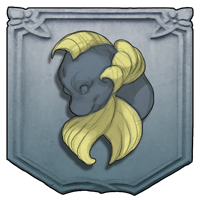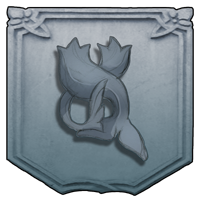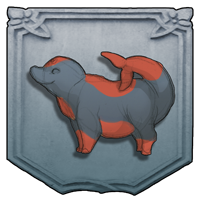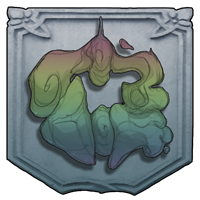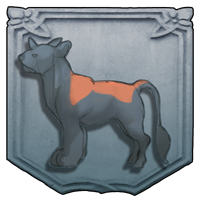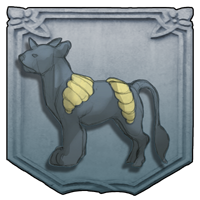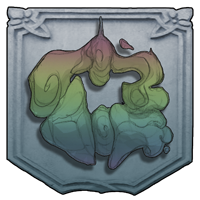Trait Categories
Sex
Describing a character's in game sex. This trait only affects how a character can breed in game.
For more info on how Arcane Zoo handles a character's Sex and Gender.
Status
Traits that shape a character's health, abilities and access to certain activities and events in game.
Status breaks down into three types:
- Natural: Blindness, deafness, or other altered physical traits, these will never stop a character from participating in game, and can be added to any character by a player on creation if they wish.
- Unnatural: Additional add-ons caused by science or magic, these mostly adjust a character's design, and only stop a character from some Prompts or Events.
- Injury: Status earned randomly during Resource Gathering, Questing, or Events. These come and go, and can be removed via Items, or Creative Prompts.
A character may have multiple Natural and Unnatural Status Traits, but will only have one Injury Status at a time, as these stack if ignored.
Minor Wound > Major Wound > Incapacitated
Skills
Skills are treated like any other trait based on rarity level, and currently have no species based restrictions.
If both parents have the same skill it passes more readily than only one parent having that skill. Common skills will pass on more often, while Rare and Legendary skills pass on less often, much like traits on any species on Arcane Zoo. Character may have a max of three skills at any time, new skills added via items or rewards will replace a current skill.
Paired Skills:
- Skills marked ‘Paired with X’ means any single character may only have ONE of these TWO paired skills EVER, these are opposing rewards and will always be paired in balance. Think of these as the same skill, with dual sides.
- If both parents have a single opposing skill pair during a breeding, it will be treated as a shared rarity level trait, but only one skill will ever pass to their offspring on a 50/50 RNG roll.
- Players adding new skills to already Imported characters may not double up any ‘paired’ skills if one is already present.
Title
As characters gain certain levels of Story Points, they earn new titles which give them access to more in game bonuses.
For more info on Character Titles.
Coat Color
Coat colors are classified by a broad range of colors divided into groups, rather than preset hexadecimal guidelines.
- Players do not need to pull directly from these sample swatches, but should make sure a created character’s coat base does not drift into ranges outside their genes.
- Coat colors may have some variation, but should remain a mostly solid color with subtle accents.
- Balikin may have a small lightening around the face, that can also include small soft areas of pink accents where the skin is more delicate, such as around the eyes and nose.
These samples show coat color variations that are too different between color accents (left sample), too solid and resemble markings (middle sample), and a gradient that is both too dark and too solid in it's edge (right sample).
Marking
Markings are dictated by the genotype of a character and each one has a set of limited guidelines for color, placement or intensity.
Don’t like the guidelines for how one of the markings including in your new genotype looks? Fear not!
- Markings DO NOT have to be drawn on a submitted character to pass approval. If you don’t like a marking, just EXCLUDE it on the Drawn Import sheet, and note that when submitting a character.
- These markings will be listed as 'Carried' on the character's details and still have the possibly of passing on during breeding.
- However, you can not ADD markings outside a character’s genotype, please do not add drawn markings if your character does not have it listed in their genotype.
Minimal White / Minimal Black:
Small markings that can be added to any character to include a little extra personality. Spots, dots, small streaks and accents are allowed in the red areas marked below. Colors should be 90% black or white, but a small shift toward the base coat color is fine.
This does not need to added to a character’s approval list of markings.
Minimal Marking Range
Flare:
A small area where Balikin may have a unique brightly colored accent. This marking should be one unbroken shape.
This does not need to added to a character’s approval list of markings.
Flare Marking Range
Mutation
Rare variations that pop up in offspring from time to time. There is no surefire way to cause them, and genotypes that do end up with them will be very special.
- While rare, it is possible for multiple mutations to pass on during a breeding.
- Parents sharing the same mutation increase the odds of an offspring also gaining it.
- New mutations can happen in any or all of the offspring of parents that don’t have mutations themselves.
Horn Type
Kirunhound: Horns are one of the Kirunhound’s defining features and come in a variety of shapes and sizes.
- Horns do not shed, and are a permanent feature that will grow over time as a Kirunhound ages.
- Horns naturally face forward, or directly upward.
- Horns are very sturdy as they’re used for battle. However, it is possible for horns to break, designs may include horns with chips, dents, bends or other damage related alterations.
- Horns may be any color, and can have some variation such as darker tips, or faint markings.
- Glowing effects can be earned through character story growth.
Body Type
Kirunhound: Show a range of body types, many showcasing the various other species brought in to keep their breeding pool alive in ages past. These descriptions are loose and just show the overall shape and feel of each body type, you do not need to copy them exactly.
Head Type
Popokee: Popokee have great variation in their facial traits due to different family lines existing along different coasts, leading to different interactions with magic and different requirements for survival.
- Popokee will naturally have no external ears and either smooth skin, or very short, flat fur on their face.
- Being aquatic, noses may be single or double blowholes on the top of the head, or small slitted nostrils on the muzzle, unless otherwise noted.
- Popokee do not have overly prominent teeth, small overlaps are common, saber teeth and other large overlaps are not.
Balikin: Heads and face traits are the easiest way to trace back to their place of origin, each having advantages for the environments they’ve adapted to.
Ear Type
Balikin: Despite the orientation they stand, Balikin ears are very expressive and move freely when listening, or to express their mood. A commonly scarred and tattered area for older Balikin, missing ears are also allowed on basic designs.
Mane Type
Popokee: Popokee manes are generally decorative, and are made up of both thicker outer hairs, and a softer undercoat to help in colder waters.
- Manes will always be a single natural solid color that falls in or outside the Coat Color.
- Manes will only change when affected by markings, mutations, or Plant Location Traits.
Tail Type
Kirunhound: Tails vary in size, shape and style, mostly feature long flowing hair like a horse, a soft brush like a dog, or a combination of the these two styles. Tails can be held high and tight to the body, straight out or even curled back over the rump. Size, length and placement is only rarely affected by tail Trait Types.
Popokee: Tails are very functional for swimming, providing Popokee with both speed and long term stamina underwater. On land, tails are used for communication with other Popokee.
Balikin: Tails have thick bases, tappering out to a thin point/. Balikins used their tails for balance on the ground, and for high speed maneuvering when in flight.
Plant Location
Popokee: A plant's location is unique to individuals, but pass on to future generations from parents.
Magic Type
Popokee: Popokee are inherently magical creatures, and are born with a set magical polarity.
- Magical Traits do not need to show, ALL physical changes listed for each magical basis are optional to add to a character’s design.
- A character’s Magic Trait will still be listed, and will affect trait rarity on breedings.
Wing Type
Balikin: Wings will act as usable hands, and will have a thumb, and potentially more fingers around the edge. Sizing should be large enough to carry them in flight, but vary between individuals.
Scale Location
Kirunhound: A Kirunhound’s scales are one of it’s defining features and allows for a lot of variations between designs. The size, shape and relative placements for these areas of scales are flexible when creating a character. Scale Type Traits also will play a part in the look, texture, and other special changes to scale location. Reading both guides as you create your character is helpful.
Tail bases can be scaled even if the listed trait places scales away from the tail base. (Koi is the only exception to this rule.)
Additional scale placements outside those listed below may be affected by scale type traits and mutations.
Scale Type
Kirunhound: A Kirunhound’s scales are one of it’s defining features and allows for a lot of variations between designs. Scale Location Traits will affect where scales will be placed on a character, reading both of these guides is helpful in creating your design.
Scales can be any solid color, and are not controlled by the coat color gene.
Small variations within this color is allowed, and some markings will allow for larger alterations of color if the marking is placed over the Kirunhound’s scales.
Accent
Balikin: The region a Balikin is born shapes not only some additional accents on their bodies, but also the Elements which they excel at controlling.
Element
Familair: The element that a particular Familair is in tune with, and will get a boost to it's skill on months that share it's typing.
